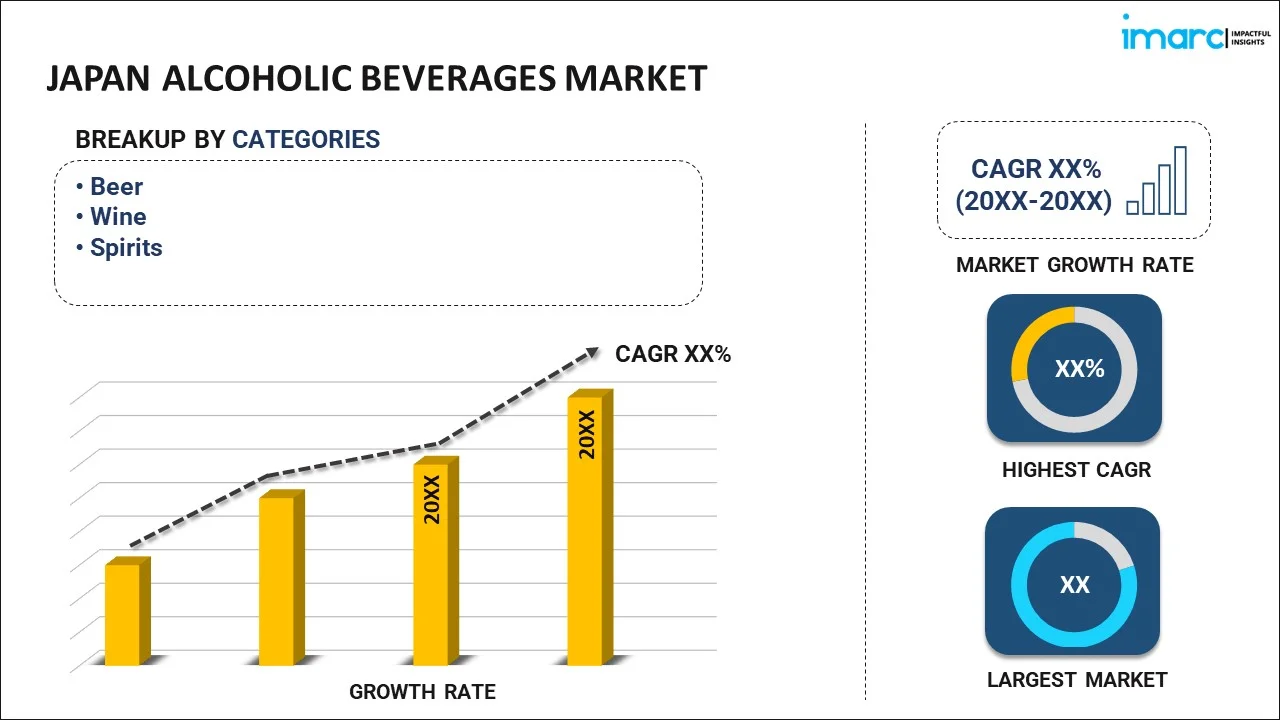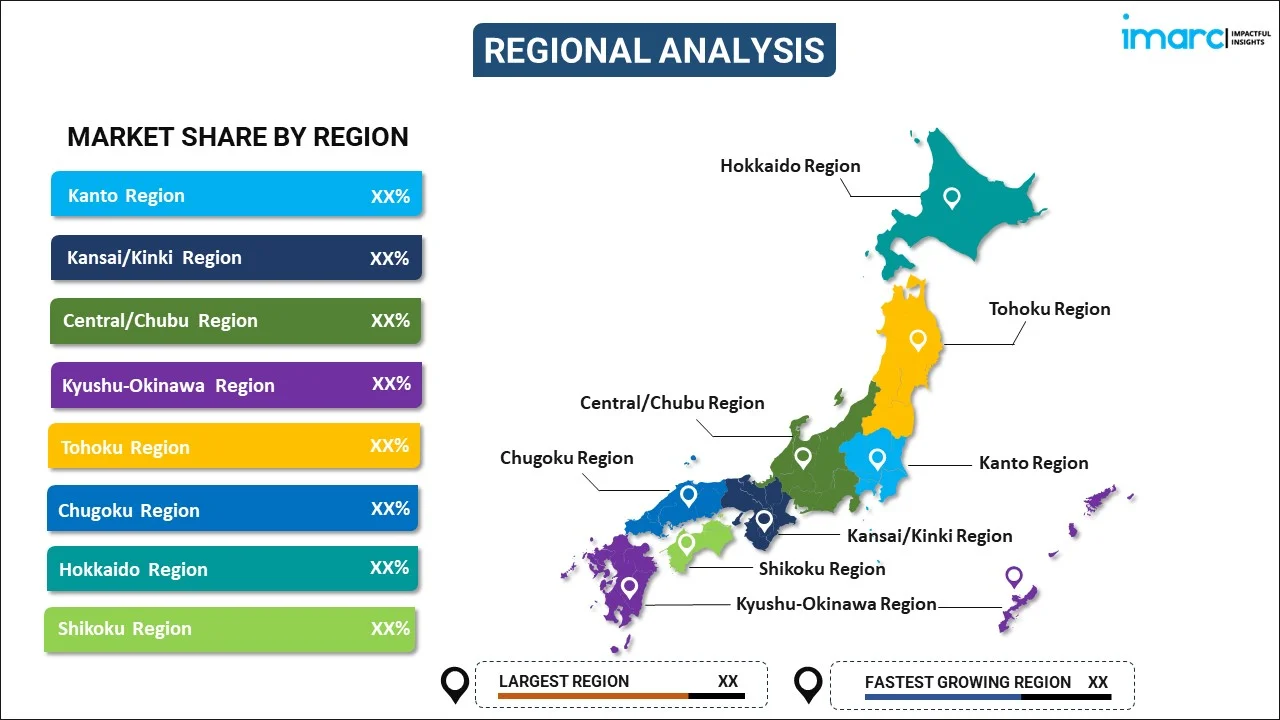
Japan Alcoholic Beverages Market Report by Category (Beer, Wine, Spirits), Alcoholic Content (High, Medium, Low), Flavour (Unflavoured, Flavoured), Packaging Type (Glass Bottles, Tins, Plastic Bottles, and Others), Distribution Channel (Supermarkets and Hypermarkets, On-Trade, Specialist Retailers, Online, Convenience Stores, and Others), and Region 2026-2034
Market Overview:
Japan alcoholic beverages market size reached 12.4 Billion Litres in 2025. Looking forward, IMARC Group expects the market to reach 16.4 Billion Litres by 2034, exhibiting a growth rate (CAGR) of 3.20% during 2026-2034. The increasing demand for effective marketing and branding strategies, such as creative advertising, endorsements, and social media campaigns that can influence consumer choices for specific alcoholic beverages, is primarily driving the market.
|
Report Attribute
|
Key Statistics
|
|---|---|
|
Base Year
|
2025
|
|
Forecast Years
|
2026-2034
|
|
Historical Years
|
2020-2025
|
|
Market Size in 2025
|
12.4 Billion Litres |
|
Market Forecast in 2034
|
16.4 Billion Litres |
| Market Growth Rate 2026-2034 | 3.20% |
Alcoholic beverages, also known as alcohol or spirits, have been consumed by humans for thousands of years. They are drinks that contain ethanol, a psychoactive substance produced through the fermentation of sugars by yeast. These beverages come in various forms, including beer, wine, and distilled spirits. Beer, one of the oldest alcoholic drinks, is made from fermented grains such as barley and wheat. It has a relatively low alcohol content and is enjoyed for its diverse flavors and styles. Wine is crafted from fermented grapes, and its production dates back to ancient civilizations. It offers a wide range of flavors, aromas, and styles, from dry and light to sweet and fortified. Distilled spirits like whiskey, vodka, and rum are created through distillation, a process that increases alcohol content. They are known for their potency and can be enjoyed straight, in cocktails, or as part of various culinary traditions. Alcoholic beverages have cultural, social, and economic significance in many societies, often playing a central role in celebrations and rituals.
Japan Alcoholic Beverages Market Trends:
The alcoholic beverages market in Japan has witnessed substantial growth in recent years, primarily due to several key drivers. Firstly, changing consumer preferences has played a pivotal role in reshaping the market landscape. Consumers are increasingly seeking unique and diverse alcoholic beverages, leading to a surge in craft breweries, distilleries, and wineries. Consequently, this has spurred innovation and competition, further boosting market growth. Furthermore, the rise of e-commerce and online retail platforms has made it easier for consumers to access and purchase alcoholic beverages, facilitating convenience and choice. The convenience factor, coupled with the ease of online product discovery and delivery, has significantly influenced market dynamics. Additionally, social trends and the growth of the experiential economy have propelled the demand for premium and high-end alcoholic beverages. Consumers are increasingly willing to spend on premium options, reflecting a willingness to explore new tastes and indulge in luxurious experiences. In conclusion, the regional alcoholic beverages market is expected to be driven by evolving consumer preferences, e-commerce, and the premiumization trend.
Japan Alcoholic Beverages Market Segmentation:
IMARC Group provides an analysis of the key trends in each segment of the market, along with forecasts at the country level for 2026-2034. Our report has categorized the market based on category, alcoholic content, flavour, packaging type, and distribution channel.
Category Insights:

- Beer
- Wine
- Still Light Wine
- Sparkling Wine
- Spirits
- Baijiu
- Vodka
- Whiskey
- Rum
- Liqueurs
- Gin
- Tequila
- Others
The report has provided a detailed breakup and analysis of the market based on the category. This includes beer, wine (still light wine and sparkling wine), and spirits (baijiu, vodka, whiskey, rum, liqueurs, gin, tequila, and others).
Alcoholic Content Insights:
- High
- Medium
- Low
A detailed breakup and analysis of the market based on the alcoholic content have also been provided in the report. This includes high, medium, and low.
Flavour Insights:
- Unflavoured
- Flavoured
The report has provided a detailed breakup and analysis of the market based on the flavour. This includes unflavoured and flavoured.
Packaging Type Insights:
- Glass Bottles
- Tins
- Plastic Bottles
- Others
A detailed breakup and analysis of the market based on the packaging type have also been provided in the report. This includes glass bottles, tins, plastic bottles, and others.
Distribution Channel Insights:
- Supermarkets and Hypermarkets
- On-Trade
- Specialist Retailers
- Online
- Convenience Stores
- Others
The report has provided a detailed breakup and analysis of the market based on distribution channel. This includes supermarkets and hypermarkets, on-trade, specialist retailers, online, convenience stores, and others.
Regional Insights:

- Kanto Region
- Kansai/Kinki Region
- Central/ Chubu Region
- Kyushu-Okinawa Region
- Tohoku Region
- Chugoku Region
- Hokkaido Region
- Shikoku Region
The report has also provided a comprehensive analysis of all the major regional markets, which include Kanto Region, Kansai/Kinki Region, Central/ Chubu Region, Kyushu-Okinawa Region, Tohoku Region, Chugoku Region, Hokkaido Region, and Shikoku Region.
Competitive Landscape:
The market research report has also provided a comprehensive analysis of the competitive landscape. Competitive analysis such as market structure, key player positioning, top winning strategies, competitive dashboard, and company evaluation quadrant has been covered in the report. Also, detailed profiles of all major companies have been provided. Some of the key players include:
- Asahi Group Holdings Ltd.
- Kirin Holdings Company Limited
- Sapporo Breweries Ltd.
- Suntory Holdings Limited
- Takara Holdings Inc.
- Tokuoka Co. Ltd.
(Please note that this is only a partial list of the key players, and the complete list is provided in the report.)
Japan Alcoholic Beverages Market Report Coverage:
| Report Features | Details |
|---|---|
| Base Year of the Analysis | 2025 |
| Historical Period | 2020-2025 |
| Forecast Period | 2026-2034 |
| Units | Billion Litres |
| Scope of the Report | Exploration of Historical and Forecast Trends, Industry Catalysts and Challenges, Segment-Wise Historical and Predictive Market Assessment:
|
| Categories Covered |
|
| Alcoholic Contents Covered | High, Medium, Low |
| Flavours Covered | Unflavoured, Flavoured |
| Packaging Types Covered | Glass Bottles, Tins, Plastic Bottles, Others |
| Distribution Channels Covered | Supermarkets and Hypermarkets, On-Trade, Specialist Retailers, Online, Convenience Stores, Others |
| Regions Covered | Kanto Region, Kansai/Kinki Region, Central/ Chubu Region, Kyushu-Okinawa Region, Tohoku Region, Chugoku Region, Hokkaido Region, Shikoku Region |
| Companies Covered | Asahi Group Holdings Ltd., Kirin Holdings Company Limited, Sapporo Breweries Ltd., Suntory Holdings Limited, Takara Holdings Inc., Tokuoka Co. Ltd., etc. (Please note that this is only a partial list of the key players, and the complete list is provided in the report.) |
| Customization Scope | 10% Free Customization |
| Post-Sale Analyst Support | 10-12 Weeks |
| Delivery Format | PDF and Excel through Email (We can also provide the editable version of the report in PPT/Word format on special request) |
Key Questions Answered in This Report:
- How has the Japan alcoholic beverages market performed so far and how will it perform in the coming years?
- What has been the impact of COVID-19 on the Japan alcoholic beverages market?
- What is the breakup of the Japan alcoholic beverages market on the basis of category?
- What is the breakup of the Japan alcoholic beverages market on the basis of alcoholic content?
- What is the breakup of the Japan alcoholic beverages market on the basis of flavour?
- What is the breakup of the Japan alcoholic beverages market on the basis of packaging type?
- What is the breakup of the Japan alcoholic beverages market on the basis of distribution channel?
- What are the various stages in the value chain of the Japan alcoholic beverages market?
- What are the key driving factors and challenges in the Japan alcoholic beverages?
- What is the structure of the Japan alcoholic beverages market and who are the key players?
- What is the degree of competition in the Japan alcoholic beverages market?
Key Benefits for Stakeholders:
- IMARC’s industry report offers a comprehensive quantitative analysis of various market segments, historical and current market trends, market forecasts, and dynamics of the Japan alcoholic beverages market from 2020-2034.
- The research report provides the latest information on the market drivers, challenges, and opportunities in the Japan alcoholic beverages market.
- Porter's five forces analysis assist stakeholders in assessing the impact of new entrants, competitive rivalry, supplier power, buyer power, and the threat of substitution. It helps stakeholders to analyze the level of competition within the Japan alcoholic beverages industry and its attractiveness.
- Competitive landscape allows stakeholders to understand their competitive environment and provides an insight into the current positions of key players in the market.
Need more help?
- Speak to our experienced analysts for insights on the current market scenarios.
- Include additional segments and countries to customize the report as per your requirement.
- Gain an unparalleled competitive advantage in your domain by understanding how to utilize the report and positively impacting your operations and revenue.
- For further assistance, please connect with our analysts.
 Request Customization
Request Customization
 Speak to an Analyst
Speak to an Analyst
 Request Brochure
Request Brochure
 Inquire Before Buying
Inquire Before Buying




.webp)




.webp)












